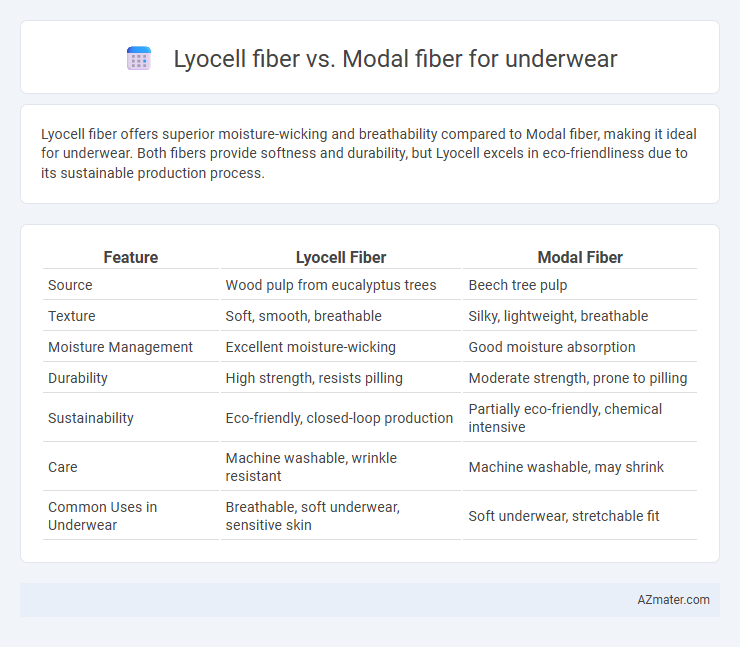Lyocell fiber offers superior moisture-wicking and breathability compared to Modal fiber, making it ideal for underwear. Both fibers provide softness and durability, but Lyocell excels in eco-friendliness due to its sustainable production process.
Table of Comparison
| Feature | Lyocell Fiber | Modal Fiber |
|---|---|---|
| Source | Wood pulp from eucalyptus trees | Beech tree pulp |
| Texture | Soft, smooth, breathable | Silky, lightweight, breathable |
| Moisture Management | Excellent moisture-wicking | Good moisture absorption |
| Durability | High strength, resists pilling | Moderate strength, prone to pilling |
| Sustainability | Eco-friendly, closed-loop production | Partially eco-friendly, chemical intensive |
| Care | Machine washable, wrinkle resistant | Machine washable, may shrink |
| Common Uses in Underwear | Breathable, soft underwear, sensitive skin | Soft underwear, stretchable fit |
Introduction to Lyocell and Modal Fibers
Lyocell and Modal fibers, both derived from sustainable wood pulp, offer exceptional softness and breathability ideal for underwear fabric. Lyocell is produced using a closed-loop process that minimizes environmental impact and provides superior moisture-wicking and durability. Modal fiber, a type of rayon, is known for its smooth texture and high tensile strength, enhancing comfort and longevity in intimate apparel.
Manufacturing Processes Compared
Lyocell fiber is produced through a closed-loop process that dissolves cellulose in non-toxic solvents, resulting in minimal environmental impact and efficient solvent recovery, while modal fiber is manufactured by chemically treating beech wood pulp with sodium hydroxide and carbon disulfide in a viscose process that involves higher chemical use and waste. The lyocell manufacturing process emphasizes sustainability and reduced water pollution, making it more eco-friendly compared to the modal fiber's traditional viscose production. These differences in production affect the fibers' softness, durability, and breathability, with lyocell offering superior moisture management and modal providing a silky, smooth feel ideal for underwear.
Eco-Friendliness and Sustainability
Lyocell fiber, derived from sustainably managed eucalyptus forests, offers superior eco-friendliness due to its closed-loop production process that recycles 99% of solvents, minimizing environmental impact. Modal fiber, made primarily from beech trees, is biodegradable and renewable but typically involves more water and chemical usage, affecting its overall sustainability profile. For underwear, Lyocell's exceptional moisture absorption and breathability combined with its lower environmental footprint make it the preferred choice for eco-conscious consumers.
Comfort and Softness in Underwear
Lyocell fiber offers superior moisture-wicking properties and breathability, enhancing comfort in underwear by keeping the skin dry and cool throughout the day. Modal fiber is renowned for its exceptional softness and smooth texture, providing a luxurious feel that reduces chafing and irritation during wear. Both fibers excel in comfort, but Lyocell's sustainable production and durability give it an edge for long-lasting, breathable underwear.
Moisture-Wicking and Breathability
Lyocell fiber offers superior moisture-wicking properties, drawing sweat away from the skin to keep underwear dry and comfortable throughout the day. Modal fiber also excels in breathability, providing enhanced air circulation that reduces heat buildup and maintains a fresh feeling. Both fibers are popular for underwear, but Lyocell's natural ability to manage moisture better suits active wearers seeking lasting dryness.
Durability and Longevity
Lyocell fiber exhibits superior durability and resistance to abrasion compared to Modal fiber, making it an excellent choice for long-lasting underwear. The molecular structure of Lyocell fibers ensures higher tensile strength and resilience to repeated washing, maintaining fabric integrity over time. Modal fiber, while soft and breathable, tends to show signs of wear and pilling faster, reducing the overall longevity of underwear products made from it.
Skin Sensitivity and Hypoallergenic Properties
Lyocell fiber, derived from eucalyptus wood pulp, offers superior moisture-wicking and breathability, making it ideal for sensitive skin in underwear due to its hypoallergenic and antimicrobial properties. Modal fiber, produced from beech tree pulp, provides exceptional softness and a smooth texture, reducing irritation for those with delicate skin but has slightly less moisture-management capability compared to Lyocell. Both fibers are biodegradable and environmentally friendly, yet Lyocell's closed-loop production process further limits chemical residues, enhancing its suitability for hypersensitive or allergy-prone skin.
Color Retention and Dyeing
Lyocell fiber exhibits superior color retention due to its smooth, non-porous surface that allows even dye absorption, resulting in vibrant and long-lasting colors ideal for underwear. Modal fiber, derived from beech tree pulp, accepts dyes well but tends to fade faster over multiple washes because of its higher moisture regain and open fiber structure. Both fibers offer excellent dye affinity, yet Lyocell's environmentally friendly closed-loop manufacturing process ensures more consistent color quality and durability in underwear applications.
Cost Efficiency and Price Comparison
Lyocell fiber offers higher cost efficiency in underwear production due to its eco-friendly closed-loop manufacturing process, reducing waste and energy consumption. Modal fiber is generally less expensive upfront but may incur higher long-term costs related to environmental impact and durability. When comparing price, Lyocell underwear typically commands a premium due to sustainability benefits, whereas Modal provides a budget-friendly alternative with softer texture.
Final Verdict: Which Fiber is Best for Underwear?
Lyocell fiber offers superior moisture-wicking and breathability, making it ideal for underwear that prioritizes comfort and odor control, while Modal fiber excels in softness and smoothness, providing a luxurious feel against the skin. In terms of durability and environmental impact, Lyocell is generally more sustainable due to its closed-loop production process and better resistance to shrinkage. For underwear combining performance, comfort, and eco-friendliness, Lyocell is often the best choice, though Modal remains a strong contender for softness-focused preferences.

Infographic: Lyocell fiber vs Modal fiber for Underwear
 azmater.com
azmater.com